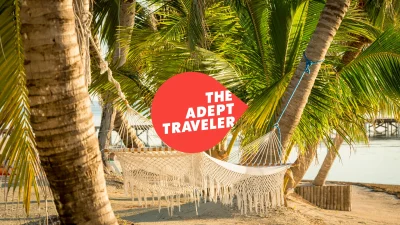Panama
Travel to Panama, a mesmerizing mosaic of breathtaking landscapes and vibrant culture, where the mighty Pacific collides with the serene Caribbean, crafting a paradise for every traveler. In Panama, travelers are greeted by the panoramic splendor of lush rainforests teeming with exotic wildlife, from the vibrant chatter of toucans to the whispering leaves of ancient trees. The enticing aroma of freshly brewed Panamanian coffee fills the air, wrapping you in its rich, comforting embrace. As you travel through its bustling streets, the melodic rhythms of salsa and reggaeton provide an irresistible soundtrack, urging you to join the dance. Relish the unique flavors of Panama’s diverse gastronomy, a tantalizing fusion of indigenous, African, and Spanish influences that explode on your palate like a vibrant fiesta. Journeying into Panama is like stepping into a kaleidoscope of sensory experiences that promises adventure, wonder, and a tapestry of unforgettable memories. Dive into this captivating destination and discover why travel to Panama is a true feast for the senses, beckoning you to uncover its endless charms.
Panama Travel Season
Travel to Panama offers an enchanting experience with its rich biodiversity, stunning beaches, and vibrant city life. Understanding the ideal season to explore this Central American paradise is key to maximizing your travel enjoyment. The best time to travel to Panama spans from December to April, when the country experiences its dry season. During these months, you can indulge in a wealth of activities without the interference of heavy rains, making it the peak travel season for Panama.
December marks the beginning of the dry season and is often the busiest month as tourists flock to Panama for a warm holiday getaway. Prices during this peak season can rise significantly, and attractions may be crowded, but the clear skies and temperate climate create a stunning backdrop for your travel to Panama. January through March remains a popular period, with festivities such as the New Year's celebrations and the vibrant Panama Jazz Festival adding to the allure.
Off-Peak Travel Advantages
For those seeking to escape the crowds and enjoy a more tranquil experience, the shoulder months of April to May present a fantastic opportunity to travel to Panama. During this period, the weather is still relatively dry, and the landscapes begin to burst with lush greenery as the rainy season approaches. As hotel prices tend to dip slightly, visitors can savor affordable luxury while immersing themselves in the allure of the nation’s natural wonders.
The green season, extending from May to November, brings with it the advantage of fewer tourists, lower costs, and beautiful blossoming landscapes. Though these months are characterized by intermittent showers, they often bring only short bursts of rain in the afternoons, leaving ample time for sightseeing and exploration. June to August is particularly special for eco-tourists, as it's the time when turtle nesting occurs along the Pacific beaches, offering a unique wildlife experience.
Local Events and Cultural Insights
Panama bursts into life with a range of vibrant local events that can enhance any travel experience. The dry season often sees indigenous festivities and cultural ceremonies, providing an immersive glimpse into the country’s traditions. In February, the Carnaval of Panama—a spectacular event rivaling Brazil's famous carnival—unfolds with parades, music, and energetic dancing. It's a must-see when planning your travel to Panama during this period.
Traveling during the rainy season provides other engaging cultural encounters. November is brimming with Panamanian pride, with the nation celebrating no less than five national holidays, including Independence Day and Flag Day. Engaging in these vibrant celebrations allows travelers to connect deeper with Panama’s rich cultural tapestry, offering a rewarding addition to any itinerary.
Crafting your travel to Panama requires a careful consideration of timing to align with your desired experiences. Whether relishing in the sun-drenched vistas during peak season or experiencing the intimate charm of less-traveled paths during the rainy months, Panama stands ready to welcome you to its varied and captivating landscapes year-round. The balanced blend of climate, festivity, and natural beauty ensures that travel to Panama is well-suited for any traveler’s preferences, promising an unforgettable journey each time.
The Weather and Seasons in Panama
Panama's weather is characterized by a tropical maritime climate, making it an appealing destination for travelers seeking warmth and sunshine. The country's geographical location, nestled between the Caribbean Sea and the Pacific Ocean, ensures a relatively stable climate throughout the year. This stability is characterized by two distinct seasons: the dry season and the rainy season, each offering different experiences for those who travel to Panama.
Dry Season in Panama
The dry season in Panama, also known locally as "summer," typically extends from mid-December through April. Travelers to Panama during this period can expect warm temperatures ranging from 75°F to 90°F (24°C to 32°C). The dry season is characterized by low humidity and minimal rainfall, making it an ideal time for outdoor activities and exploration, whether you're planning on basking on the Pacific beaches or hiking in the lush highlands. With clear skies and bright sunshine, this season is recommended for those looking to avoid the inconvenience of rain while experiencing Panama's natural beauty.
Rainy Season in Panama
While the rainy season, or "winter," spans from May to November, it is a period mixed with sunny mornings and frequent afternoon showers. Temperatures remain fairly consistent, generally ranging from 78°F to 88°F (26°C to 31°C), but the rainfall brings higher humidity levels. Despite its reputation, the rainy season offers travelers to Panama the unique appeal of lush, vibrant landscapes, especially in regions like the Panama Canal, which comes to life with thriving greenery. This season is less crowded with tourists, offering a more intimate experience of Panama's wildlife and natural scenery.
Optimal Travel Period and Special Events
For those considering travel to Panama, the months from January to March are considered optimal. During this period, the weather is predominantly dry, and several festivals and events take place, highlighting the rich cultural tapestry of Panama. One such event is the Panama Jazz Festival in January, attracting music lovers from around the globe. Moreover, the colorful celebrations of Carnaval, typically occurring in February or March, are a joyful spectacle worth experiencing.
Traveling to Panama off-peak during the rainy season can offer a different, yet equally captivating experience with opportunities for eco-adventures such as rainforest hikes and river rafting. Always ensure to pack appropriately for changing weather conditions during this time, including light rain gear and breathable clothing.
Overall, Panama offers a welcoming climate for travelers year-round, each season bringing its own distinct charm and opportunities for adventure. Whether you choose to travel to Panama for its sun-drenched beaches during the dry season or its lush rainforests in the rainy season, the country's warm welcome and diverse experiences await.
Accepted Payment Methods and Other Payment Information in Panama
When planning your travel to Panama, understanding the local payment options can enhance your experience and prepare you for transactions during your visit. Panama uses the Panamanian Balboa (PAB) as its local currency, but the U.S. dollar (USD) is also widely accepted and is essentially a second official currency. The Balboa is pegged 1:1 with the U.S. dollar, and most of the currency in circulation is actually U.S. dollars. Coins may feature Balboa denominations, but paper money is usually in U.S. dollars. This dual currency system makes it convenient for travelers from the United States, as they can use their currency without needing to exchange it.
Credit card usage is pervasive in Panama, particularly in cities and tourist areas. Visa and Mastercard are most commonly accepted, and you will generally find these options available at hotels, restaurants, and larger retail outlets. American Express is also accepted, but not as ubiquitously as Visa or Mastercard. Discover card appears to have limited acceptance, so it's advisable for travelers relying on this card to have an alternative payment method. When traveling to Panama, it's always a good idea to notify your bank about your travel plans to avoid any inconveniences with credit card transactions being flagged as fraudulent activity.
Though credit cards are widely used, cash is still king in many parts of Panama, particularly in rural areas or small businesses. It's beneficial to have cash on hand when you travel to Panama, especially for smaller purchases, transportation, and tipping. ATMs are widely available in cities and towns, and they distribute U.S. dollars, making it easy to withdraw cash as needed. However, be aware of potential fees that your home bank might charge for international withdrawals.
Tipping etiquette in Panama is similar to that in the U.S. In restaurants, a tip of 10% is generally expected, and many bills already include a "propina," or tip, so it’s good to check your bill before leaving more. For taxi drivers, a small tip is appreciated but not obligatory unless they assist with bags or provide extra service. Hotel staff, such as bellhops or housekeeping, typically expect a small tip of $1-2 for their services.
When traveling to Panama, be mindful of your safety, particularly when handling cash, to reduce the risk of theft or loss. It's advisable to carry only small amounts and to use credit cards for larger transactions when possible. Understanding these payment nuances can help make your travel to Panama smoother and more enjoyable.
Why You Should Travel to Panama
Travel to Panama and discover a true gem in the heart of Central America. With its unique blend of cultures, vibrant cities, and breathtaking natural beauty, Panama offers travelers an unparalleled experience. Here’s why you should consider visiting.
The Panama Canal: Engineering Marvel and Historic Landmark
Travel to Panama wouldn't be complete without witnessing the iconic Panama Canal. This feat of engineering not only connects two oceans but also represents a pivotal moment in global trade history. Watching massive ships navigate through the locks is a captivating experience, and the Canal's visitor centers offer informative exhibits detailing its construction and significance.
Cultural Melange: A Rich Tapestry of Traditions
Panama's diverse cultural landscape is a fusion of indigenous traditions, Afro-Caribbean heritage, and European influences. Festivals like Carnaval and the vibrant celebrations in Portobelo bring this cultural diversity to life, offering travelers a chance to immerse themselves in local music, dance, and culinary delights. Travel to Panama to witness this vibrant cultural tapestry firsthand.
Pristine Beaches and Idyllic Islands
For those seeking sun and sand, Panama is a paradise. The country's coastline offers stunning beaches like those on the San Blas Islands and Bocas del Toro. These unspoiled destinations are perfect for relaxation and exploration, boasting crystal-clear waters and vibrant marine life, providing the perfect setting for snorkeling and diving adventures.
A Haven for Outdoor Adventurers
Travelers with a thirst for adventure can find plenty of it in Panama. Hike through the lush rainforests of the Darien Gap, or tackle the challenging trails of Volcán Barú, Panama's highest peak. Birdwatchers will marvel at the vast variety of species, especially in regions like Boquete and Soberanía National Park.
Panama City: A Cosmopolitan Capital
Panama City is a dynamic metropolis where old meets new. The modern skyline is juxtaposed against the historic architecture of Casco Viejo, a UNESCO World Heritage site. This contrast creates a vibrant atmosphere with a plethora of dining, shopping, and entertainment options. The city’s nightlife is also buzzing, with trendy bars and clubs to explore.
Exquisite Biodiversity and National Parks
Travel to Panama and explore its remarkable biodiversity in numerous national parks and protected areas. Coiba National Park, a UNESCO World Heritage site, offers exceptional diving opportunities with its diverse marine species. Meanwhile, the cloud forests and wildlife sanctuaries across the country safeguard many unique plant and animal species.
Coffee Culture and Culinary Delights
Panama offers a burgeoning coffee culture that travelers will find appealing. Regions like Boquete, known for producing some of the world’s finest coffee, provide tours that let you taste exquisite brews right at the source. The culinary scene is equally enticing, with local dishes featuring fresh seafood and indigenous ingredients alongside international cuisines.
Indigenous Communities and Traditions
Visiting Panama provides an opportunity to engage with indigenous communities like the Guna Yala and Emberá. These communities offer guided tours that provide insights into their traditional lifestyles, crafts, and customs. Travelers seeking to understand a different facet of Panama's cultural heritage will find these encounters enriching.
Diverse Ecosystems and Ecotourism
Panama's geographical location endows it with a variety of ecosystems, from rainforests to coral reefs. This makes it a prime destination for ecotourism. Sustainable travel initiatives ensure that travelers can enjoy the natural splendor while helping to preserve these vital environments for future generations.
Ease of Travel and Connectivity
Travel to Panama is made convenient by the country's modern infrastructure and connectivity. The Tocumen International Airport is a major hub in the Americas, offering numerous international flights. Additionally, Panama’s strategic location and use of the US dollar simplify travel logistics, making it a hassle-free destination for international visitors.
The History of Panama
Panama boasts a rich and fascinating history that makes it an attractive destination for history lovers looking to travel. The country's strategic location as the crossroads of the Americas has made it a focal point for commerce and exploration over the centuries. From the days of pre-Columbian civilizations to its vital role in global trade today, Panama offers visitors a unique glimpse into a storied past that continues to shape its identity. The indigenous tribes like the Emberá and Guna people initially inhabited the region, and their cultural heritage is still evident in the art and traditions of Panama today.
The Spanish arrival in the early 16th century marked a significant turning point in Panama's history. Travel to Panama allows visitors to explore the remnants of this era, such as the ruins of Panamá Viejo, the original Panama City, founded in 1519 and now a UNESCO World Heritage site. These ruins stand as a testament to Panama's early importance in the Spanish colonial empire, serving as a launch point for expeditions across the Pacific. The construction of the more fortified Casco Viejo, also a UNESCO site, came after the sacking of the city by the pirate Henry Morgan in 1671, and it remains one of Panama's most charming and historically significant districts.
The story of Panama would not be complete without mentioning the Panama Canal, an engineering marvel that is key to understanding the nation's modern identity. Completed in 1914, the canal transformed global shipping routes and has been pivotal in international trade. Traveling to Panama to see the canal allows history enthusiasts to witness one of the 20th century's greatest engineering achievements. The Miraflores Locks, a popular visitor center, offers an in-depth look at the canal's operation and the role it played during both World Wars, underscoring Panama's continued strategic importance.
In addition to its historical landmarks, Panama's vibrant cultural heritage makes it a must-see destination for those who travel in search of history. The Panamanian cultural landscape is a colorful tapestry of indigenous, African, and European influences. Visitors can explore traditional dances, music, and culinary experiences that reflect this diverse blend. Festivals such as the annual Carnival, held in the month leading up to Lent, display the country's unique cultural fusion, celebrated with grand parades, vibrant costumes, and traditional music. For anyone planning to travel to Panama, these cultural events and historic sites are compelling reasons to explore this dynamic and historically fascinating nation.
The Culture of Panama
The culture of Panama is a vibrant tapestry that reflects the country's history and its diverse population. As one travels through Panama, the unique blend of cultures, including indigenous, Spanish, and African influences, becomes apparent. This cultural melange is most vividly experienced in the day-to-day life and special celebrations that occur throughout the year. Travelers who venture to Panama will find a country that embraces its multicultural identity with pride, where the locals are welcoming and eager to share their rich heritage.
One of the most captivating aspects of Panama is its lively festivals and traditional celebrations. The Carnival of Panama is an event that stands out, drawing both locals and visitors from all over the world. Celebrated with fervor in towns and cities across the country, the four-day festival includes parades, dances, and music, highlighting the Spanish and African influences on Panamanian culture. Moreover, the celebration of "Las Tablas" is particularly famous for its elaborate costumes and traditional "polleras," showcasing Panama's dedication to preserving its historical sartorial art. For travelers, joining these celebrations offers an immersive experience into Panamian society.
Daily customs in Panama reflect a blend of modern and traditional practices. Panamanians place significant importance on family, and social gatherings often involve extended relatives and friends. Mealtime is an essential part of daily life where scrumptious local dishes like "sancocho" and "patacones" are shared. These moments offer travelers a chance to engage with everyday Panamanian life and its people, fostering connections that enhance any travel experience. Panama’s art scene is just as diverse, with influences from its indigenous populations, visible in the intricate molas created by the Guna Yala people. These handmade textiles are not only souvenirs but also a storytelling medium that shares the history and beliefs of Panama’s native communities.
Traveling to Panama provides a unique opportunity to explore the country's indigenous cultures. Panama is home to several indigenous groups, such as the Guna, Embera, and Ngäbe-Buglé, each with its own distinct cultural practices and traditions. Efforts to preserve these indigenous cultures are evident in local and national initiatives, including sustainable tourism projects that allow travelers to visit indigenous territories and learn about their way of life respectfully. This cultural preservation not only benefits the indigenous communities by supporting their economies but also enriches the broader cultural mosaic of Panama, offering deeper, more authentic travel experiences for those visiting the country. These collaborative, educational efforts highlight Panama’s commitment to cultural preservation, ensuring that tradition continues to be an integral part of the nation's identity.
The Culinary Experience of Panama
Travel to Panama, and you'll discover an enchanting culinary landscape that is as diverse and vibrant as its culture and history. Panama's cuisine is a delightful fusion of African, Spanish, and Indigenous influences, creating a unique tapestry of flavors that delights the palate. From bustling city eateries to tranquil beachside grills, the food scene in Panama offers something for every taste. Traditional Panamanian dishes highlight the use of fresh seafood, tropical fruits, and locally grown vegetables, making the most of the abundant resources from both the Pacific Ocean and the Caribbean Sea. As you travel through Panama, you'll notice that the culinary experience is a direct reflection of the country's rich and varied cultural heritage, with recipes passed down through generations.
One must-try dish when you travel to Panama is "sancocho," a hearty stew often made with chicken, yucca, corn, and flavorful herbs. It is a beloved comfort food that epitomizes Panamanian cooking. Seafood lovers will revel in dishes like "ceviche," a refreshing mix of raw fish marinated in lime juice, which serves as a popular street food snack. "Ropa vieja," shredded beef served with rice and plantains, offers a taste of the country's Spanish colonial past. Don't miss out on trying "patacones," twice-fried plantains that are crispy on the outside and tender on the inside, often served alongside meals as an irresistible side dish. These traditional foods showcase the versatility and creativity of Panamanian chefs, impressing both locals and tourists alike.
When it comes to beverages, travel to Panama introduces you to local treasures such as "seco," a sugarcane spirit cherished in the region, often enjoyed neat or mixed into fruity cocktails. Panama also has a growing craft beer scene, with breweries like Casa Bruja and Cervecería Feroz offering unique, locally brewed selections that are quickly gaining popularity both domestically and abroad. Wine enthusiasts may be surprised by the burgeoning interest in Panamanian wine, with vineyards like Bodega Varela Hermanos branching out into viticulture. In Panama, these drinks are more than just a way to quench your thirst; they are a part of the culture and enhance the communal dining experience often shared among friends and family.
Dining experiences in Panama are as varied as the dishes themselves. Visitors can explore the vibrant food markets that abound, such as Mercado de Mariscos in Panama City, where freshly caught seafood is sold daily. Street food is equally abundant, with vendors offering everything from "empanadas" to "tamales," giving travelers an authentic taste of everyday Panamanian life. Fine dining in Panama will also entice those looking for an upscale experience, with restaurants like Maito and Donde José showcasing innovative menus that incorporate traditional ingredients in modern ways. Throughout the year, the country hosts a number of food festivals celebrating both local and international flavors, providing occasions to indulge in seasonal delicacies. For those with dietary restrictions, Panama’s culinary scene is increasingly accommodating, with numerous restaurants offering vegan, vegetarian, and gluten-free options, ensuring a memorable dining experience for all who travel to Panama.
What to See and Do in Panama
Travel to Panama and immerse yourself in its vibrant culture, diverse landscapes, and unique experiences waiting to be discovered. Panama, known for its famous canal and rich history, offers a variety of attractions for every type of traveler. From families seeking educational experiences to solo adventurers in search of thrilling activities, this enchanting country has something for everyone.
Explore the Engineering Marvel of the Panama Canal
Visiting the Panama Canal is a must for anyone traveling to Panama. This engineering masterpiece connects the Pacific and Atlantic Oceans and offers a fascinating insight into global trade. Families will enjoy the Miraflores Visitor Center, where interactive exhibits explain the canal's history and operations. Witnessing a massive ship passing through the locks is a momentous occasion, setting the stage for a deeper appreciation of this vital waterway.
Wander Through the Narrow Streets of Casco Viejo
The historic district of Casco Viejo, in Panama City, is an architectural gem that transports visitors back in time. Explore its narrow cobblestone streets lined with beautifully restored colonial buildings. Boutique hotels, charming cafes, and art galleries make it a perfect spot for solo travelers to indulge in the local culture. Don't forget to stop by the Iglesia de San José to see the famous golden altar.
Venture into the Breathtaking Wilderness of the Darien Jungle
Adventure seekers should not miss the opportunity to explore the Darien Jungle, a vast and remote wilderness teeming with wildlife. Guided tours provide a thrilling expedition into this untouched paradise, where travelers may encounter rare species like the harpy eagle. With expert guides, discover hidden waterfalls and enjoy an authentic experience with indigenous communities, providing an unforgettable adventure in Panama.
Relax on the Exquisite San Blas Islands
If tranquility and pristine beaches are what you seek, the San Blas Islands offer the perfect idyllic escape. This archipelago of around 365 islands is managed by the Guna Yala people, preserving their unique culture and traditions. Families and couples will appreciate the simple accommodations and opportunities to snorkel in the crystal-clear waters. The islands are also ideal for immersing yourself in the traditional lifestyle of the Guna people and enjoying their hospitality.
Discover the Rich Biodiversity of Soberania National Park
Soberania National Park is a haven for nature enthusiasts traveling to Panama. Located just a short drive from Panama City, this lush forest is home to an array of wildlife, including toucans, monkeys, and sloths. Trekking the park's trails offers a chance to experience Panama's rich biodiversity firsthand. Birdwatchers will revel in the chance to spot some of the hundreds of species that inhabit this verdant paradise.
Experience the Vibrant Culture at the Azuero Peninsula
The Azuero Peninsula, often considered the cultural heart of Panama, offers a rich tapestry of traditions, music, and festivals. Visitors can experience vibrant folk festivals, such as the famous Carnival of Las Tablas. Artisans in this region create beautiful handicrafts, providing perfect souvenirs to remember your travel to Panama. The peninsula is an ideal stop for those wanting to dive deep into the essence of Panamanian culture.
Marvel at the Boquete Coffee Plantations
The mountainous region of Boquete is renowned for its world-class coffee plantations, offering tours that allow travelers to witness the coffee-making process from bean to cup. In this region, climate and altitude create the perfect conditions for growing high-quality coffee. Solo travelers and groups can savor some of the finest brews while enjoying the stunning landscapes, making for an enriching and flavorful journey.
Embark on a Whale Watching Adventure in the Golfo de Chiriquí
For wildlife enthusiasts, particularly between July and October, the Golfo de Chiriquí offers an incredible spectacle of humpback whales migrating from the Antarctic. Guided tours provide an opportunity to witness these magnificent creatures breaching and playing in the warm Panamanian waters. This experience can be particularly memorable for families, as it combines education with the sheer wonder of nature.
Delight in the Flavors of Panamanian Cuisine
Sampling local cuisine is an essential part of any trip to Panama. The country's dishes fuse African, Spanish, and Indigenous influences, offering a distinct culinary identity. From savoring a traditional sancocho soup in a local eatery to trying street food like carimañolas, food lovers will find Panama a delightful destination. Gourmet travelers can also enjoy fine dining experiences in Panama City’s acclaimed restaurants.
Unwind in the Natural Thermal Springs of El Valle de Antón
Set in the cradle of an enormous ancient volcano, El Valle de Antón is a picturesque town known for its natural beauty and thermal springs. Perfect for family visits, the area offers botanical gardens, a vibrant market, and opportunities for hiking. The rejuvenating thermal waters provide relaxation and are a must-visit for those looking to unwind after exploring Panama's bustling streets and rugged landscapes.
Tips & Tricks for Traveling in Panama
Travel to Panama can be an exhilarating experience with its vibrant culture, stunning landscapes, and rich history. To make your trip seamless and rewarding, here are 10 practical tips and tricks that will enhance your travel experience in Panama.
Understand the Local Currency
When you travel to Panama, an important step is familiarizing yourself with the local currency. Panama's currency, the Balboa, is used interchangeably with the US Dollar, which is also accepted everywhere. This means you don't need to worry about exchanging your currency if you're coming from the United States. However, it’s wise to keep small denominations on hand, as larger notes can be difficult for vendors to change, particularly in rural areas. It's also worth noting that coins are used extensively, including US coins, so be sure to have a good mix in your wallet.
Embrace the Public Transportation System
Public transportation is not only affordable but also a genuine way to experience local Panamanian life. The Metrobus system in Panama City is efficient and connects most of the main areas. Arm yourself with a Metro card, which you can purchase at any major bus or metro station, to save on travel costs. While buses throughout the country may not follow strict timetables, they are a cost-effective way to travel long distances. Just be prepared for some unpredictable and adventurous rides!
Visit Off-Peak Tourist Destinations
To avoid crowds and enjoy a more authentic experience, consider visiting lesser-known spots in Panama. The San Blas Islands, while popular, offer a private paradise if visited during the shoulder seasons. Alternatively, places like Isla Taboga or the Azuero Peninsula can be explored to find hidden gems without the overwhelming crowds. These areas often provide a raw and untapped beauty, giving you insight into the local culture and natural wonders.
Learn Basic Spanish Phrases
Communication is key when traveling, and learning some basic Spanish can enhance your experience in Panama. While many Panamanians in urban areas speak English, rural communities may not. Knowing simple phrases such as "hola" (hello), "gracias" (thank you), and "dónde está el baño?" (where is the bathroom?) can be highly beneficial. This effort can make interactions more pleasant and show respect to the local culture.
Explore Beyond Panama City
While Panama City is a vibrant metropolis with plenty to offer, don’t limit your travel to just this area. Consider exploring the colorful scenery of Bocas del Toro, the historic appeal of Casco Viejo, and the lush jungles of Darien National Park for a more comprehensive view of the country. These destinations showcase diverse ecosystems and provide opportunities for unique excursions like hiking, bird-watching, and cultural tours.
Bargain at Local Markets
Visiting local markets can give you a glimpse into everyday life in Panama, where bargaining is a common cultural practice. When shopping for souvenirs or local goods, especially in artisanal markets, feel free to negotiate prices. This practice is not only accepted but expected, and can be a fun way to engage with locals and understand the value of handmade crafts and products.
Photography Tips for Capturing Panama’s Beauty
For photographers visiting Panama, take advantage of the golden hour to capture the exquisite light reflecting off the Panama Canal or the cityscape. The diverse landscapes, from cloud forests to pristine beaches, provide a range of textures and colors to experiment with. Also, consider investing in a good-quality waterproof case or camera, as the tropical climate can be unpredictable, and sudden downpours are not uncommon.
Stay In Local Accommodations
To truly immerse yourself in Panamanian culture, consider staying in locally owned accommodations such as guesthouses or boutique hotels. This not only supports the local economy but often provides a more personalized experience compared to international hotel chains. You may gain unique insights from your hosts and recommendations for authentic experiences off the beaten path.
Respect Local Customs and Traditions
Panama is home to a diverse range of cultural practices and traditions that travelers should respect. When visiting religious sites, dress appropriately – covering shoulders and legs is generally advised. Additionally, Sundays are family-focused days, and many shops and restaurants may have limited hours, so plan your itinerary accordingly. Engaging respectfully with these customs enriches your travel experience and fosters meaningful interactions with locals.
Prepare for the Weather
The climate in Panama can vary greatly, from humid lowlands to cooler highlands. Pack accordingly by bringing light, breathable clothing for the hot and humid coastal areas, and layers for cooler nights in the highland regions. Always carry a rain jacket or poncho, as Panama’s weather can be unpredictable with frequent tropical showers. Being prepared ensures you're comfortable and ready to explore regardless of the weather conditions.
What To Know Before You Go to Panama
When considering travel to Panama, it's essential to prepare by understanding the entry requirements and local customs to ensure a smooth and enjoyable experience. To enter Panama, travelers need a valid passport. Many nationalities, including U.S. and EU citizens, do not require a visa for stays of up to 90 days. However, it is advisable to check with the Panamanian consulate or embassy for the latest requirements. A return or onward ticket is typically necessary, and travelers might need to demonstrate sufficient funds for their stay.
Health Precautions and Vaccinations
Before traveling to Panama, ensure you're aware of the recommended vaccinations and health precautions. The Centers for Disease Control and Prevention (CDC) advises that all travelers should be up to date on routine vaccines, such as measles-mumps-rubella (MMR), diphtheria-tetanus-pertussis, and polio. Additionally, vaccines for hepatitis A, hepatitis B, typhoid, and rabies are recommended for some travelers. If you plan to visit certain provinces, particularly in rural areas, a yellow fever vaccination might be necessary. Travel insurance is also a smart investment to cover potential medical expenses or unforeseen travel disruptions.
Local Customs and Etiquette
Awareness of Panama's local customs and etiquette will greatly enhance your travel experience. Panamanians are generally warm and hospitable. It is customary to greet people with a handshake, and in more informal settings, a light kiss on the cheek or a hug is common. Politeness and respectful attire, particularly in churches and rural communities, are highly regarded. It's also considered respectful to ask permission before taking photographs of individuals.
Transportation Options
Traveling within Panama is convenient, with several transportation options available. Tocumen International Airport in Panama City serves as the main gateway. For city travel, taxis and ridesharing services are widely available and relatively affordable. Panama’s public buses, known as "Diablos Rojos," are an adventurous and economical option, though not always punctual. For inter-city travel, domestic flights and long-distance buses can efficiently cover longer distances.
Tipping Culture
Understanding the tipping culture is crucial when you travel to Panama. In restaurants, a 10% tip is typically added to the bill, though giving an additional tip for exceptional service is common. It's also considerate to tip hotel staff, tour guides, and taxi drivers. While tipping is not obligatory, those working in the service industry often appreciate the gesture.
Common Phrases and Communication Tips
Spanish is the official language in Panama, and knowing some common phrases can be extremely helpful. Greetings like "Hola" (Hello) and "Gracias" (Thank you) are widely used. If you're unfamiliar with Spanish, carrying a translation app can facilitate communication. Locals often appreciate any effort to speak their language, and many individuals in the tourism industry speak English. Practicing clear, simple English can also bridge any communication gaps.
Accessibility in Panama
Panama is increasingly becoming a destination of choice for travelers seeking a rich blend of natural beauty, cultural heritage, and modern amenities. As tourism continues to flourish, there's a growing emphasis on ensuring that travel to Panama is accessible to individuals with diverse needs. From those with limited mobility to travelers requiring visual or auditory accommodations, Panama is making strides in inclusivity, though there is still progress to be made.
Physical Accessibility for Travelers with Limited Mobility
When considering travel to Panama, individuals with limited mobility or those using wheelchairs will find that major urban centers are more equipped with necessary facilities compared to rural areas. Panama City, the country's vibrant capital, offers a relatively higher level of accessibility. Many of the city's newer infrastructure projects and public spaces are designed with consideration for wheelchair access, including wide sidewalks and ramps. However, older parts of the city and historic attractions might present challenges due to their cobblestoned paths and lack of ramps.
Accessible Public Transportation in Panama
Public transportation is a critical aspect of accessibility in Panama. The Metro system in Panama City is somewhat accessible as it includes elevators and ramps at several stations to cater to individuals with mobility issues. Public buses have a more varied level of accessibility, with some buses offering spaces for wheelchairs, though this is not uniformly the case across the country. Taxi services, including ride-sharing options, may offer wheelchair-accessible vehicles upon request, thus facilitating travel to Panama for those needing mobility support.
Accommodations with Accessibility Features
Accommodations across Panama, particularly in Panama City and other popular tourist areas, are increasingly attentive to accessibility needs. Many hotels offer rooms designed for guests with mobility impairments, featuring amenities such as roll-in showers and grab bars. It's advisable for travelers to verify specific accessibility features with accommodations prior to booking to ensure they meet individual needs.
Visual and Auditory Accommodations
In terms of visual and auditory accommodations, Panama’s progress is slower. Some tourist attractions and public facilities offer braille signage and auditory guides, but these are not widespread. For travelers who are hard of hearing, ensuring that venues equipped with induction loops or captioning services are available can require some pre-planning and research. The government's commitment to improving accessibility across all sectors, however, promises enhancements in these areas in the future.
Accessible Tourist Attractions in Panama
For tourists exploring Panama, several attractions are working towards improved accessibility. For example, the Panama Canal, one of the country's most iconic landmarks, has made efforts to accommodate visitors with disabilities, including wheelchair-accessible viewing platforms. Nature reserves and national parks, which are enthusiastically promoted as part of travel to Panama, vary in accessibility. Some offer boardwalks and viewing areas designed for wheelchair users, while others may require more adventurous access. For any traveler, including those with specific needs, engaging with tour operators who specialize in accessible tours can significantly enhance the experience.
By continuing to enhance accessibility features, Panama offers travelers, regardless of their needs, the chance to enjoy its myriad attractions, from bustling urban centers to serene natural landscapes. As infrastructure improvements and awareness grow, travel to Panama is becoming more inclusive, opening its wonders to all visitors.
Health & Safety in Panama
When planning travel to Panama, it is crucial to understand the various safety concerns that might affect your trip. Panama is a captivating destination with vibrant cultures and stunning landscapes, but like any place, awareness of potential risks can help ensure a safe and enjoyable visit.
Water Safety
While exploring Panama, being mindful of water safety is significant, particularly if you are visiting coastal regions or planning water-related activities. The country's coastlines are known for strong currents, so it's advisable for travelers to heed local advice and warnings posted on beaches. When engaging in activities like swimming, surfing, or boating, ensure that you are aware of safety regulations and necessary precautions to avoid accidents and injuries.
Natural Disaster Risks
Travel to Panama also involves being cognizant of natural disaster potentials, notably earthquakes and severe weather events, including hurricanes in specific areas. While Panama is outside the main hurricane belt, precautionary awareness is essential. The rainy season, generally from May to November, can lead to heavy rains and potential flooding. Always stay updated with local news and weather forecasts to maintain situational awareness during your trip.
Crime and Safety
Crime, including incidents of pickpocketing and theft, is a consideration in Panama, particularly in urban areas. Travelers should exercise caution in crowded spots and tourist destinations where pickpockets may operate. It's wise to keep personal belongings secure, avoid displaying valuables, and be aware of your surroundings, especially at night. Some areas experience higher crime rates, so researching and understanding which locales to avoid can further ensure personal safety while traveling in Panama.
Political and Social Unrest
While Panama is generally stable, travelers should remain informed about any potential political or social unrest that could impact travel plans. Demonstrations and protests do occur and can sometimes lead to disruptions. Being aware of advice from local authorities, as well as current events before and during travel, will help mitigate these risks.
Health and Safety Precautions
To safeguard against health risks during travel to Panama, travelers should verify their access to healthcare facilities and consider necessary vaccinations. It's recommended to consult with a healthcare provider prior to traveling to discuss vaccinations such as hepatitis A and B, typhoid, and yellow fever, especially if planning to visit rural or jungle areas. Familiarizing yourself with the availability and quality of healthcare services where you will be traveling is beneficial. Access to potable water varies, so choosing bottled water and avoiding ice made from tap water can prevent waterborne illness.
By understanding and addressing these safety concerns, your travel to Panama can be both safe and rewarding, allowing you to fully experience the country's rich culture and natural beauty.
Other Places You Might Like
Costa Rica - If you loved traveling to Panama for its lush rainforests and vibrant wildlife, then Costa Rica will surely captivate you. Known for its biodiverse ecosystems, this Central American gem offers a similar tropical allure with abundant national parks, pristine beaches, and opportunities for adventure. From hiking the trails of the Arenal Volcano to observing the rich marine life in its coastal waters, Costa Rica provides a perfect blend of nature and adventure travel that echoes what you experienced in Panama. With a focus on ecotourism and sustainability, visitors can enjoy the natural beauty while supporting conservation efforts, making it a dream destination for eco-conscious travelers.
San Blas Islands, Panama - For those who fell in love with Panama's Caribbean side, the San Blas Islands provide an even more enthralling experience. Nestled off Panama's eastern coast, this archipelago is a utopia of white sandy beaches, crystal-clear waters, and vibrant coral reefs. Home to the indigenous Guna Yala people, it offers a unique cultural immersion alongside its natural beauty. Travel to these idyllic islands is a step into a serene paradise where you can relax, snorkel, and learn about traditional Guna culture, delivering the ultimate in escapist travel to Panama.
Cayman Islands - Like Panama, the Cayman Islands offer a captivating underwater world that's a dream for snorkeling and diving enthusiasts. Known for their clear, calm waters and dazzling marine life, these islands are perfect for travelers who enjoyed Panama for its aquatic adventures. With famous sites like Stingray City and the Kittiwake Shipwreck, the Cayman Islands provide an unforgettable underwater travel experience. Additionally, the islands feature beautiful beaches and a laid-back island vibe that Panama lovers will appreciate.
Boquete, Chiriquí, Panama - Adventure seekers and nature enthusiasts who enjoyed travel to Panama will love Boquete for its stunning highland landscapes and outdoor activities. Nestled in the lush mountains of Chiriquí, this charming town is known for its coffee plantations, hiking trails, and the nearby Baru Volcano. Whether you're exploring the Cloud Forest, zip-lining through the canopy, or indulging in the world-renowned Panamanian coffee, Boquete offers a unique blend of relaxation and excitement, making it a must-visit for those who can't get enough of Panama's natural wonders.
Antigua, Guatemala - If Panama's historical richness captivated you, then Antigua will certainly pique your interest. This UNESCO World Heritage site is famed for its well-preserved Spanish colonial architecture and vibrant culture. Surrounded by picturesque volcanoes, Antigua offers a striking blend of history, culture, and natural beauty. Walk its cobbled streets, explore ancient ruins, and embrace the festive atmosphere that resembles the historical and cultural depth one experiences when traveling to Panama.
Final Thoughts
Embarking on a journey to Panama promises an experience packed with vibrant culture, breathtaking landscapes, and bustling modernity. When you travel to Panama, you'll find a destination that seamlessly blends traditional charm with contemporary allure. From the lush rainforests of the Darien Province to the cosmopolitan vibe of Panama City, this stunning country offers a wide array of attractions that cater to every type of traveler.
Whether you're exploring the historical marvel of the Panama Canal, diving into the crystal-clear waters around the San Blas Islands, or savoring the rich flavors of Panamanian cuisine, each moment spent here is sure to captivate and inspire. Travel through Panama’s vibrant landscapes, and enjoy its welcoming atmosphere where diverse wildlife, serene beaches, and enchanting islands meet the warmth of its people.
It's easy to see why Panama stands out as a must-visit destination on every travel enthusiast's list. So, when planning your next adventure, consider the magic and diversity that travel to Panama offers. Allow its rich tapestry of experiences to speak to your wanderlust, and start your next unforgettable journey in this captivating corner of the world.
Panama City, Panama

Venezuela Airspace Warning Disrupts Caribbean Routes

2027-28 Caribbean Cruises From Florida, Royal Caribbean
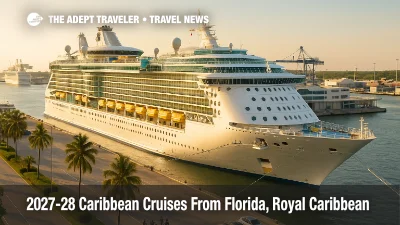
Venezuela Airspace Warning Reroutes Caribbean Flights

Panama Canal Transit Rebound Eases 2026 Cruise Risk
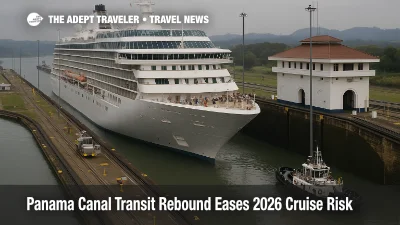
FAA Alert Cuts Brazil Venezuela Flights

Venezuela Flight Suspensions After FAA Airspace Warning

Star Clippers end-of-summer sale, up to $600 OBC

G Adventures 18-to-Thirtysomethings Adds 38 New Trips
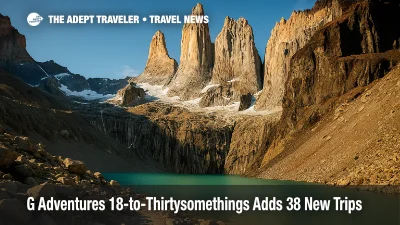
Save on Tall-Ship Sailings with Star Clippers' Christmas in July Deal

Bocas del Toro Unrest: What Travelers Need to Know Now
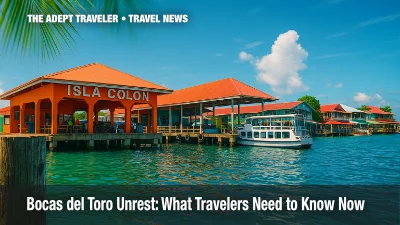
Is It Safe to Drink the Water in Central America? Essential Guide
